Evolution
Game preparation
With /join 2-5 players can enter the game. With /start the game begins. Alternatively, you can use the game management use.
The game
Players try to secure the survival of their species by feeding them, increasing populations, and ensuring their best possible development by increasing body size and learning new skills. All animals are first plant eaters that feed from the food supply on the water hole. They can become this by the property of carnivores and then feed on other animal species.
Players will receive points for:
- the food that has eaten your own animal species during the game,
- the population size of the surviving species,
- the number of property cards of the surviving species.
Material
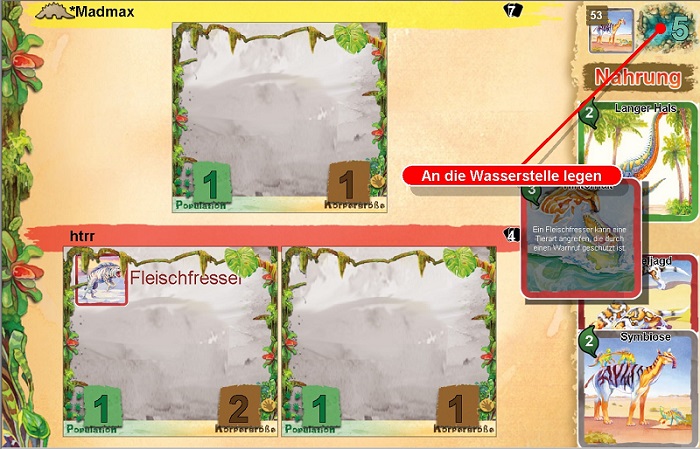
110 cards, including 14 carnivores. The other 16 cards are 6 times each. The nutritional values range from -3 to +9. Animals and food in unrestricted supply.
Game sequence
A game of evolution is played over several rounds. The end of the game is loaded when the post-drawing pile is used up, then another round is played. Each round consists of the following phases:
- Cards
- Set food supply
- Playing cards
- Before eating
- Cheese
- Billing
Map
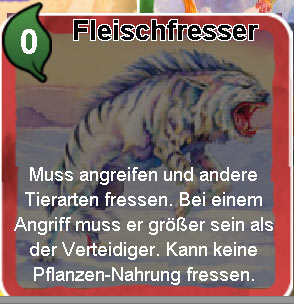
Each card can be used for all the above actions. Each card shows in the upper left corner the amount of food it provides if it is played as a food card. The image and its name characterize the property that gives the cards to the animal when played as a property to an animal
Cards
At the beginning of each round, the players got 3 property cards hidden and 1 more for each species lying in front of them.
Set food supply
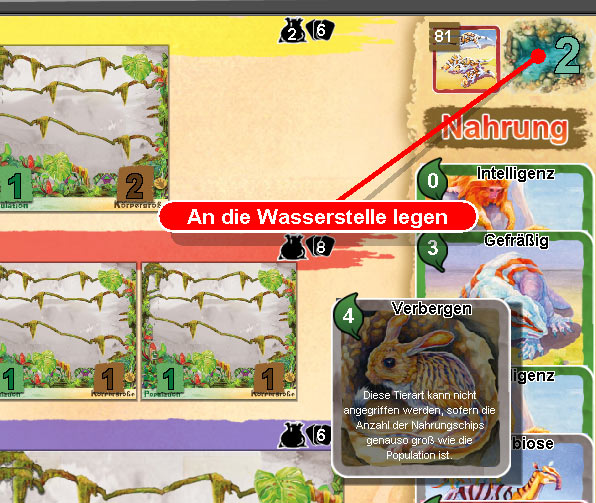
Players choose a handcard at the same time and place it hidden on the water hole. These food cards determine how much herbal food is available in this round. However, they are only exposed to freseses at the beginning of the phase. Until then, only the remaining food from the preliminary round is displayed.
Playing cards
Beginning with the starter and then clockwise, each player comes to the row once and can then play as many property cards as he wants. Unplayed cards will be kept on hand for the next round.
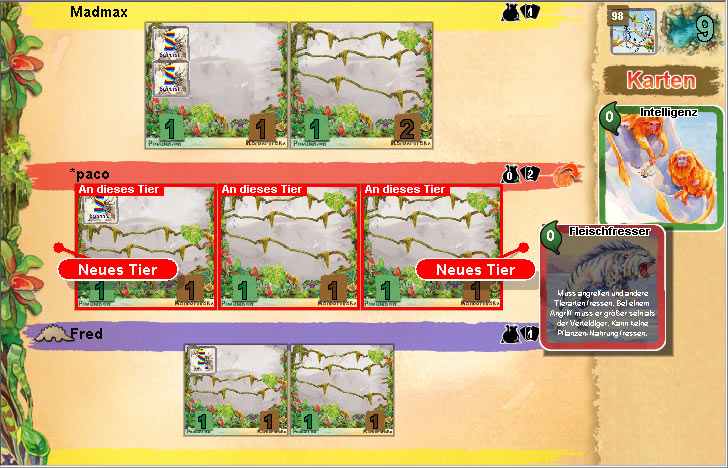
One player can perform one of the following 3 actions per card:
- Get a new species
- Increase body size or population
- Playing a property
To play a new species left or right next to its already existing species, the player clicks the appropriate button after selecting the card. No new animals can be placed between the existing animals.
In order to perform one of the other two actions, the player selects the desired animal after selecting the card.
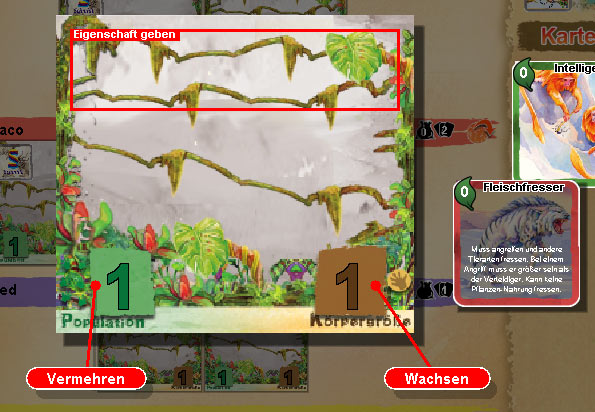
To enlarge the body size or population, it then clicks the corresponding button on the left or right at the bottom of the animal map.
To play a property, a player clicks on the framed area in the middle of the card. A species may not have a maximum of 3 properties (for 2 players a maximum of 2 cards) and the same property 2x. If a player of an animal type, at which the maximum number of cards already exists, wants to assign a new property, he must overbuild one of the existing properties.
Before eating
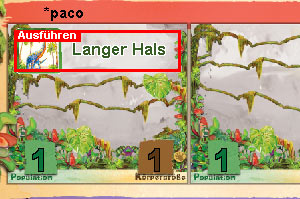
The food maps are now exposed and the food supply is adjusted accordingly. If the resulting sum is negative, no food comes into play.
Animals with properties
- Long neck
- Fertility
- Fat layer
- Intelligence (only as a plant eater)
can now start using them at the starter by clicking them. The executable cards are marked. In order to use the intelligence, one has to mark one of the handcards for discarding.
Cheese
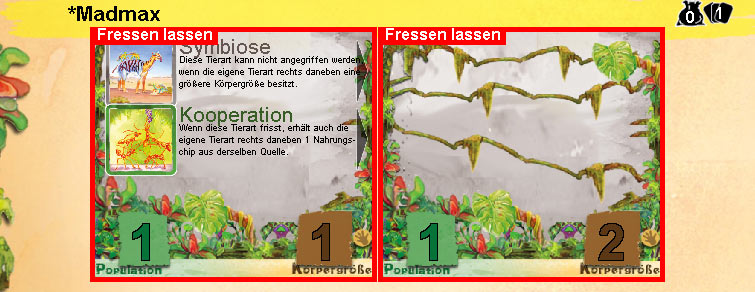
Starting with the starter, all players must now always feed any of their hungry animal species by clicking. As a result, this also receives a plurality of food chips, or by additional properties. Important: Feeding is repeated reihum until all animal species of players are no longer hungry or can no longer be fed due to lack of food. A species is hungry until the number of food chips corresponds to the size of the population. If a player has fed all his animal species, he will be skipped by further feeding and the remaining players feed on reihum without him.
Feeding plant eaters
In principle, each species is a plant eater first. To feed them, one click on the animal is sufficient. They get their food from the supply at the water hole, which is displayed at the top right. Some properties (such as frying) affect the amount of food that a player may take from the water hole. Only with the fat layer, however, can an animal type obtain more food chips than the associated population.
Feeding meat eaters
Meat eaters also have to eat as long as they are still hungry. However, they never eat vegetable food, even with the help of properties such as long neck or cooperation. They eat by attacking other species. As long as carnivores are not yet satisfied, they will continue to attack even when the plant food is out on the water hole. If necessary, a player must also attack their own animal species. An attack can always be carried out successfully if the body size of the carnivore is greater than the body size of the attack and the carnivore has properties that eliminate the defense properties of the animal species to be attacked. All attackable animals are marked after the selection of a meat eater, one click then executes the attack. After a successful attack, the population of the attacked species is first reduced by 1. If the population falls below 1, the species of animals is extinct (see extinction). The meat eater then receives as much food as it corresponds to the body size of the attacked species. This naturally does not reduce the supply of plant food.
A carnivore can put other animals out of force by using the intelligence properties. For this purpose, it selects a hand card, activates the inelligenz and finally clicks on the desired property. This is now deactivated in ALL animal species until the attack has taken place. Of course, this applies only to this meat eater, which is therefore marked green.
It should also be noted that a carnivore eats NIE herbal food, but a plant eater can eat meat, for example, by the Aasfresser property or also cooperation.
End of feeding
Feeding ends when all animal species have absorbed so much food by the players that the respective number of food chips corresponds to the size of their population or if no hungry species can absorb more food. If a species could not absorb enough food, the population of this species is reduced to the number of existing food chips. If a species has not eaten food, the population size drops to 0 (the species dies – see extinction). All food chips still lying on the water hole after feeding remain there for the next round. Each player who has no more species will receive a new stock free of charge. All food chips are removed from the animal species and count at the end of the game as victory points. The current number can be seen on the right in its status bar on the right side of the bag. The next player becomes a new starter and receives the starter marker.
extinction
When the population of a species falls to 0, it is extinct and immediately removed. All food chips still on the extinct animal species count as points at the end of the game. All property cards present thereon are thrown open onto the storage stack. The player will receive as many new cards as the extinct species. If a species extinct between two other species of animals is extinct, the remaining species of animals will slide together. So there are no gaps.
Playing
If the redrawing stack is used up, the depositing stack is mixed and placed as a new redrawing stack. This induces the gamer: if the storage stack in the phase has to be remixed cards, this is the beginning of the last round. The game ends after eating. If the storage stack is mixed in another phase of the game, this round is played to the end and then a complete round is played. Only after that is the score. The last round is displayed by the bell at the drawer stack.
Value
Players receive win points at the end of the game as follows:
- per food chip eaten in the game 1 victory point.
- for the population size of each surviving species 1 victory point per stage
- 1 victory point for each property card bearing against the tableaus of the surviving species.
The player with most points wins.
Tiebreaker
If there are several players with the same score, the number of property cards of the surviving species is the first Tiebreaker.
Second Tiebreaker is the sum of populations of surviving species.
Map
A list of all 17 properties with explanations can be found in the original guide from page 6.

